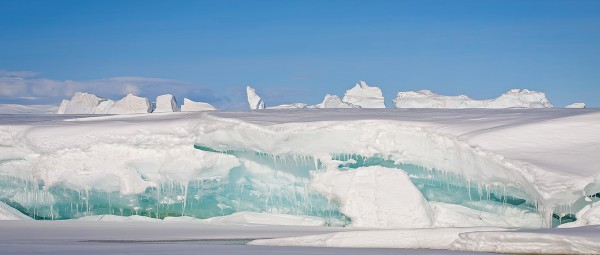Neutrinos are referred to as ghost particles, and they flow through the universe at lightning speed. To track them down, ultrasensitive detectors are set up in extreme locations in the Antarctic.
During each second while you’re reading this article, trillions of these ultra-high-energy, astrophysical elementary particles are shooting through your body as well. The Neutrinos interact practically with nothing, and their mass is close to zero, there’s (nearly) nothing and no one that can stop them. They even move through our planet Earth largely without incurring any loss. Neutrinos are created in various ways, for instance, during nuclear reactions in the Sun, some are even assumed to have been travelling ever since the Big Bang. Neutrinos are the second-most prevalent elementary particles in the universe after photons. The current state of science distinguishes between three different types: electron neutrinos, muon neutrinos and tau neutrinos.
Scientists are eager to track down the ghost particles because they help explain the existence of the cosmos and existence. Researchers at Rochester and North Carolina Universities in the United States pursued a different approach: In 2012, they were the first to send a message through solid matter utilising neutrinos. A proton accelerator generated a neutrino beam that was captured by a neutrino detector 100 meters (328 feet) below the ground.

Let’s now look at Schaeffler’s contribution to neutrino research. To do so, we need to visit the Antarctic or, more precisely, Moore’s Bay and the multinational ARIANNA (Antarctic Ross Ice-Shelf Antenna Neutrino Array) project, where researchers found a rare constellation: sonar investigations showed that the plane ice shield with a thickness of nearly 600 meters (1,968 feet) sits on the water surface underneath it, which, as a result, appears like a huge mirror. The photon radiation left in the ice by the neutrinos is reflected to detectors on the surface of the ice, providing “ghost traces” that can be analysed.
In the dark Antarctic winter that’s beginning now, wind turbines supply the electric power to the neutrino detectors of the project. Temperatures as low as –50 °C (–58 °F) make maximum demands on the wind turbine bearings. However, due to low wind speeds, the bearings not only have to withstand extreme temperatures but also run with very low friction. Based on its comprehensive know-how and long-standing experience in special-purpose bearings, Schaeffler uses specialty grooved ball bearings with ceramic balls. They don’t require oil or grease and have a particular type of seal. The design has proven to be very robust. The wind turbines withstand the harsh ambient conditions with aplomb and reliably supply the detectors with electricity.


In the summer of 2022, research will continue at an even colder place in Antarctica, where temperatures drop as low as –65 °C (¬–85 °F). The wind blows even more irregularly there and sometimes at even slower speeds than before. That’s why the turbines will become larger, requiring larger bearings delivering equally reliable performance with even lower friction. Schaeffler will supply a suitable bearing solution for these requirements as well.
